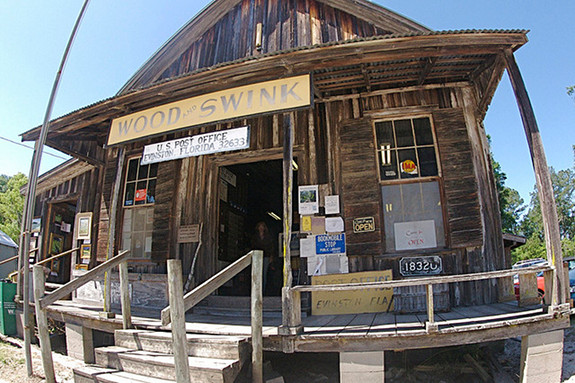
The Evinston Post Office, which opened in 1882, is the oldest working post office in Florida. (Photo: Flickr.)
By Ralph De La Cruz
Florida Center for Investigative Reporting
Making numbers work can be a challenging mental exercise. But when it comes to budgets, balancing a ledger may be the easiest part of the process. Numbers on a spreadsheet don’t complain or feel anxious. The numbers 5 or 9 don’t have homes or families to care for.
That’s why it’s so easy for people to call for millions, billions or even trillions in cuts. They’re just numbers. Big numbers.
Some of those big numbers today belong to the United States Postal Service. For the second straight year, the USPS is facing a budget shortfall of more than $8 billion.
So on Sept. 15, after more than a month of warning that the Post Office was in dire straits, Postmaster General Patrick Donahoe followed the lead of American companies and governments and proposed deep cuts at the USPS. He wants to cut 250 processing centers, 3,700 post offices and 120,000 jobs.
Ultimately, Donahoe hopes to save about $3 billion through those cuts.
Big numbers are being moved around on the USPS’s piece of paper. But this weekend, St. Petersburg Times reporter Jeff Klinkenberg did a beautiful job of explaining what just $61,000 on that balance sheet really means.
He tells the story of the oldest working post office in the state. The Evinston Post Office, which opened in 1882, is one of 34 in Florida scheduled for closure.
“Florida’s oldest working post office has creaked in the wind in summer, smelled of orange blossoms in winter and transacted business in three different centuries,” Klinkenberg writes in a piece that can only be described as a paean to a time left behind, if not forgotten.
Located in a wooded, rural region between Gainesville and Ocala, the Evinston Post Office serves only 80 families. It’s a 5-by-12-foot corner of the Wood and Swink General Store. But it’s the kind of place where people go to fill out forms, get help understanding how things work, and share stories.
“When somebody is sick, you hear about it when you come to get your mail,” Marguerite Deaderock told Klinkenberg. When Deaderock’s husband died, her neighbors heard about it at the post office, went home and began cooking meals for her.
Once the post office closes, the 80 families will be served by the office in Micanopy. Being off the beaten path and serving such a small constituency no doubt played into the decision to place this post office on the list. But it’s also why its closure would be so lamentable, and why it’s being fought so hard by Evinston’s customers. How many folks in Miami or Tampa would petition their elected officials and the postmaster general if their neighborhood post office closed?
It’s not simply about isolating 80 families — it’s about how local culture is affected and about the end of another American institution: the rural post office.
Technology is changing our world, and this economic downturn only spurs the pace of that change. It’s happened before. Remember, there used to be a time when you got milk delivered on your doorstep. Advancements in refrigeration and transportation, and the expansion of mega-grocers ended that. Today, technology and the bottom line are affectively ending such former staples of our lives as the morning paper — and now, the rural post office.
How could an institution that created the Pony Express and Air Mail to reach remote areas leave behind rural families today? Certainly the Pony Express and Air Mail — two of the USPS’s iconic achievements — must not have been cost-effective when they started.
But they were investments in the emerging technologies of the day. In a world of e-mail and overnight delivery, it’s postal service that’s out-dated, almost quaint.
Except to the 80 families who do business there.
